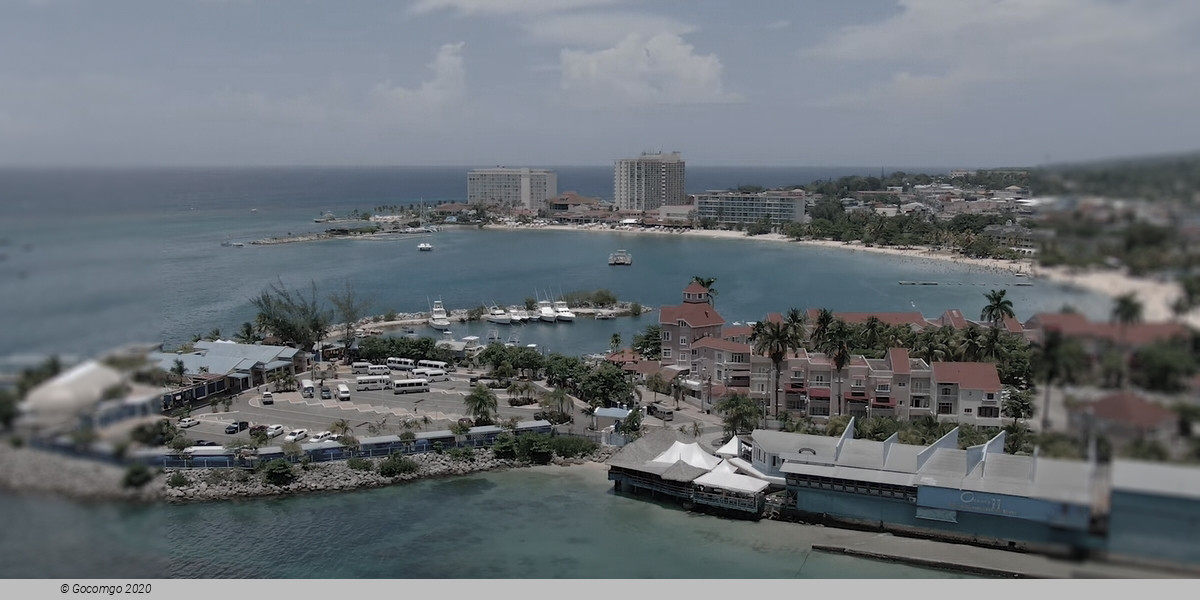Ocho Rios

Ocho Rios is a town in the parish of Saint Ann on the north coast of Jamaica and is more widely referred to as Ochi by locals. Beginning as a sleepy fishing village, Ocho Rios has seen explosive growth in the last decade to become a popular tourist destination featuring duty-free shopping, a cruise-ship terminal, world-renowned tourist attractions and several beaches and acclaimed resorts. In addition to being a port of call for cruise ships, Ocho Rios also hosts cargo ships at the Reynolds Pier for the exportation of sugar, limestone, and in the past, bauxite.
History
Ocho Rios was originally settled by a tribe of Arawak Indians called Taíno, who had settled in Jamaica around 1,000 BCE and called the land Xamayca, meaning land of wood and water. After Christopher Columbus landed in 1494 and claimed the island for Spain, Ocho Rios was named Las Chorreras, meaning rapid rivers. The Taínos were ultimately obliterated by disease, slavery, and war. Some also committed suicide, presumably to escape their conditions as slaves. Spain brought the first enslaved Africans to Jamaica in 1517, to work on plantations throughout Jamaica, including Ocho Rios.
In May 1655, British forces seized the island from the Spanish. The English misunderstood, misinterpreted, and mispronounced the Spanish name Chorreras and called the town Ocho Rios, which sounded close enough. In 1657 and 1658 the Spanish, sailing from Cuba, failed to retake the island in fierce battles in and around Ocho Rios known as the Battle of Las Chorreras.
Historically, Ocho Rios did not have any prominent role in either the English or the Spanish. It was, however, utilized by pirates who along with Port Royal, regarded it as a perfect base of operations.
When slavery was officially abolished in Jamaica in the year of 1834, the town entered a period of poverty and rebirth. With colonial interests removed, the history of Ocho Rios was crafted by the newly-freed slaves, who embraced their newfound freedom and slowly turned the town into a stable and peaceful fishing village.
Although plantations developed during colonial times, Ocho Rios never evolved as a fruit-shipping port of any consequence. Things began to change in the 1940s when Reynolds Jamaica Mines built the deep-water Reynolds Pier west of town. An overhead conveyor belt still carries bauxite ore 10 km from the Reynolds open-cast mines at Lydford, in the hills south of town.
Nonetheless, Ocho Rios was still just a quiet village in the 1960s,e when the Jamaican government formed the St Ann Development Company (SADCo), under the direction of the Urban Development Corporation (UDC), and then began systematic development. It dredged the harbor and built a small marina, reclaimed the shore, brought in sand for Turtle Beach, and built shopping and housing complexes.
In January and February 1967, Martin Luther King Jr. stayed in Ocho Rios, with his wife Coretta and two employees, to draft his fourth and final book, Where Do We Go From Here: Chaos or Community?. By the early 1980s, Ocho Rios' character had been established: a meld of American-style fast-food franchises, nondescript shopping malls, an enclave of mediocre hotels in town, and more tasteful, upscale hotels a discrete distance east. The construction of Island Village, a major shopping and entertainment complex, has spruced up 'Ochi.' In 1968, the Jamaica Villa Association (JAVA) was created to represent the growing number of villas in Jamaica. Ocho Rios has seen the rise of luxury villas, with beachfront, ocean, and mountain views.
Today, Ocho Rios extends four miles between Dunn's River Falls, two miles to the west of the town center, and the White River, two miles to the east. Almost all the development outside the center is to the east.

